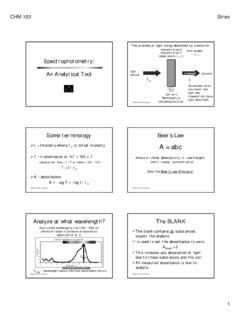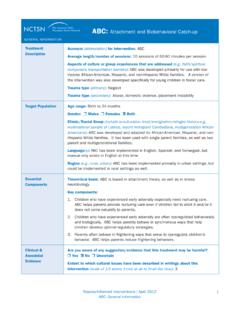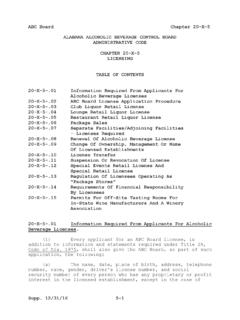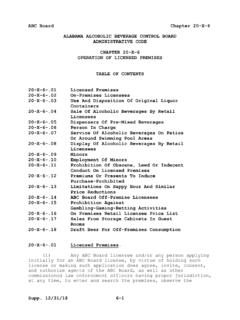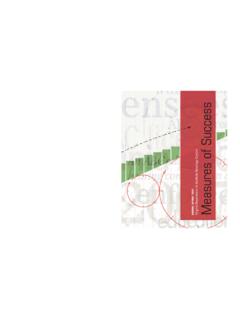Transcription of The ABC of Simulation Estimation with Auxiliary Statistics
1 The ABC of Simulation Estimation with Auxiliary StatisticsJean-Jacques Forneron Serena Ng August 2016 AbstractThe frequentist method of simulated minimum distance (SMD) is widely used in economicsto estimate complex models with an intractable likelihood. In other disciplines, a Bayesianapproach known as Approximate Bayesian Computation (ABC) is far more popular. Thispaper connects these two seemingly related approaches to likelihood-free Estimation by means ofa Reverse Sampler that uses both optimization and importance weighting to target the posteriordistribution. Its hybrid features enable us to analyze an ABC estimate from the perspective ofSMD. We show that an ideal ABC estimate can be obtained as a weighted average of a sequenceof SMD modes, each being the minimizer of the deviations between the data and the contrasts with the SMD, which is the mode of the average deviations.
2 Using stochasticexpansions, we provide a general characterization of frequentist estimators and those based onBayesian computations including Laplace-type estimators. Their differences are illustrated usinganalytical examples and a Simulation study of the dynamic panel Classification: C22, : Indirect Inference, Simulated Method of Moments, Efficient Method of Moments,Laplace Type Estimator. Department of Economics, Columbia University. Email: Department of Economics, Columbia University, and NBER. Email at Address: 420 W. 118 St. Room 1117, New York, NY support is provided by the National Science Foundation (SES-0962431 and SES-1558623). We thank RichardDavis for discussions that initiated this research, Neil Shephard, Christopher Drovandi, two anonymous referees, andthe editors for many helpful suggestions.
3 Comments from seminar participants at Columbia, Harvard/MIT, UPenn,and Wisconsin are greatly appreciated. All errors are our IntroductionAs knowledge accumulates, scientists and social scientists incorporate more and more features intotheir models to have a better representation of the data. The increased model complexity comes ata cost; the conventional approach of estimating a model by writing down its likelihood function isoften not possible. Different disciplines have developed different ways of handling models with anintractable likelihood. An approach popular amongst evolutionary biologists, geneticists, ecologists,psychologists and statisticians is Approximate Bayesian Computation (ABC). This work is largelyunknown to economists who mostly estimate complex models using frequentist methods that wegenerically refer to as the method of Simulated Minimum Distance (SMD), and which include suchestimators as Simulated Method of Moments, Indirect Inference, or Efficient Methods of ABC and SMD share the same goal of estimating parameters using Auxiliary Statistics that are informative about the data.
4 An SMD estimator minimizes theL2distance between and an average of the Auxiliary Statistics simulated under , and this distance can be made asclose to zero as machine precision permits. An ABC estimator evaluates the distance between and the Auxiliary Statistics simulated for each drawn from a proposal distribution. The posteriormean is then a weighted average of the draws that satisfy a distance threshold of >0. There aremany ABC algorithms, each differing according to the choice of the distance metric, the weights,and sampling scheme. But the algorithms can only approximate the desired posterior distributionbecause cannot be zero, or even too close to zero, in both SMD and ABC use simulations to match ( ) to (hence likelihood-free), the rela-tion between them is not well understood beyond the fact that they are asymptotically equivalentunder some high level conditions.
5 To make progress, we focus on the MCMC-ABC algorithm due toMarjoram et al. (2003). The algorithm applies uniform weights to those satisfying ( ) and zero otherwise. Our main insight is that this can be made very close to zero if we combineoptimization with Bayesian computations. In particular, the desired ABC posterior distributioncan be targeted using a Reverse Sampler (or RS for short) that applies importance weights to asequence of SMD solutions. Hence, seen from the perspective of the RS, the ideal MCMC-ABCestimate with = 0 is a weighted average of SMD modes. This offers a useful contrast with theSMD estimate, which is the mode of the average deviations between the model and the data. Wethen use stochastic expansions to study sources of variations in the two estimators in the caseof exact identification.
6 The differences are illustrated using simple analytical examples as well assimulations of the dynamic panel of models with a non-smooth objective function is challenging, even when the1 Indirect Inference is due to Gouri eroux et al. (1993), the Simulated Method of moments is due to Duffie andSingleton (1993), and the Efficient Method of Moments is due to Gallant and Tauchen (1996).1model is not complex. The Quasi-Bayes (LT) approach due to Chernozhukov and Hong (2003) useBayesian computations to approximate the mode of a likelihood-free objective function. Its validityrests on the Laplace (asymptotic normal) approximation of the posterior distribution with the goalof valid asymptotic frequentist inference. The Simulation analog of the LT (which we call SLT)further uses simulations to approximate the intractable relation between the model and the show that both the LT and SLT can also be represented as a weighted average of modes withappropriately defined importance central theme of our analysis is that the mean computed from many likelihood-free poste-rior distributions can be seen as a weighted average of solutions to frequentist objective permits us to turn the focus from computational to analytical aspects of the pos-terior mean, and to provide a bridge between the seemingly related approaches.
7 Although ouroptimization-based samplers are not intended to compete with the many ABC algorithms that areavailable, they can be useful in situations when numerical optimization of the Auxiliary model isfast. This aspect is studied in our companion paper Forneron and Ng (2016) in which implemen-tation of the RS in the overidentified case is also considered. The RS is independently proposed inMeeds and Welling (2015) with emphasis on efficient and parallel implementations. Our focus onthe analytical properties complements their paper proceeds as follows. After laying out the preliminaries in Section 2, Section 3 presentsthe general idea behind ABC and introduces an optimization view of the ideal MCMC-ABC. Section4 considers Quasi-Bayes estimators and interprets them from an optimization perspective.
8 Section5 uses stochastic expansions to study the properties of the estimators. Section 6 uses analyticalexamples and simulations to illustrate their differences. Throughout, we focus the discussion onfeatures that distinguish the SMD from ABC which are lesser known to PreliminariesAs a matter of notation, we useL( ) to denote the likelihood,p( ) to denote posterior densities,q( )for proposal densities, and ( ) to denote prior densities. A hat denotes estimators that correspondto the mode and a bar is used for estimators that correspond to the posterior mean. We use (s,S)and (b,B) to denote the (specific, total number of) draws in frequentist and Bayesian type analysesrespectively. A superscriptsdenotes a specific draw and a subscriptSdenotes the average overSdraws.
9 For a functionf( ), we usef ( 0) to denote f( ) evaluated at 0,f j( 0) to denote2 The class of SMD estimators considered are well known in the macro and finance literature and with apologies,many references are omitted. We also do not consider discrete choice models; though the idea is conceptually similar,the implementation requires different analytical tools. Smith (2008) provides a concise overview of these finite sample properties of the estimators are studied in Michaelides and Ng (2000). Readers are referred to theoriginal paper concerning the assumptions jf ( ) evaluated at 0andf , j, k( 0) to denote 2 j kf ( ) evaluated at , we assume that the datay= (y1,..,yT) are covariance stationary and can berepresented by a parametric model with probability measureP where RK.
10 The truevalue of is denoted by 0. Unless otherwise stated, we writeE[ ] for expectations taken underP 0instead ofEP 0[ ]. If the likelihoodL( ) =L( |y) is tractable, maximizing the log-likelihood`( ) = logL( ) with respect to gives ML= argmax `( ).Bayesian Estimation combines the likelihood with a prior ( ) to yield the posterior densityp( |y) =L( ) ( ) L( ) ( )d .(1)For any prior ( ), it is known that MLsolves argmax `( ) = lim exp( `( )) ( )d exp( `( )) ( )d . Thatis, the maximum likelihood estimator is a limit of the Bayes estimator using replicationsof the parameter is the cooling temperature in simulated annealing, a stochasticoptimizer due to Kirkpatrick et al. (1983) for handling problems with multiple the case of conjugate problems, the posterior distribution has a parametric form which makesit easy to compute the posterior mean and other quantities of interest.










